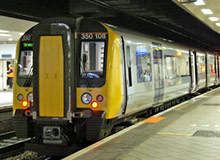
After years of campaigning and controversy over alternative routes, the British Prime Minister Gordon Brown, on October 5 this year, agreed a funding package that indicates London's controversial Crossrail project will proceed. But the announcement did not please a number of industry bodies who in the past had been encouraging of the Crossrail scheme.
The UK-based Association for Consultancy and Engineering (ACE) was quite vocal in its own disapproval, and it was not the only body concerned by the timing and circumstances that now surround Crossrail.
In October 2007, ACE chief executive Nelson Ogunshakin said "Given current skills shortages, resourcing Crossrail and projects like it will be challenging."
Estimated to cost £16bn, the electrified 118km (73.5 mile) Crossrail system is scheduled to run eastwards from Maidenhead along the Great Western main line towards Paddington, joined by the Heathrow Airport spur. An approximately 16km (10 mile) tunnel section beneath central London from just west of Paddington to near the Pudding Mill Lane DLR station constitutes the scheme's largest single engineering component.
A total of 41km (25.5 miles) will be in single bore tunnels. An arm will extend to Abbey Wood in south-east London, with the longer arm proceeding along the Great Eastern mainline to the Crossrail terminus at Shenfield.
See Also:
EUROPE'S LARGEST CIVIL ENGINEERING PROJECT
How well do you really know your competitors?
Access the most comprehensive Company Profiles on the market, powered by GlobalData. Save hours of research. Gain competitive edge.

Thank you!
Your download email will arrive shortly
Not ready to buy yet? Download a free sample
We are confident about the unique quality of our Company Profiles. However, we want you to make the most beneficial decision for your business, so we offer a free sample that you can download by submitting the below form
By GlobalDataCrossrail is about more than creating a route from existing alignments and new builds; it is about creating access to stations, the construction of these (seven underground-located stations), interchanges with Transport for London (TfL) stations and making existing infrastructure compatible with the projected peak service of 24 ten-car trains in each direction.
With so much to consider, Crossrail will follow in the footsteps of the Channel Tunnel, Berlin's Potsdamer Platz and Heathrow Airport Terminal 5 in becoming Europe's largest civil engineering project. Furthermore, it will be threaded through one of the world's most intensively developed sites, with tightly packed existing sub-surface infrastructure, notably power supplies, sewers and TfL Underground.
Parliamentary approval is expected in 2008 and much financial, legal and planning lies ahead, but there is confidence that construction will start in 2010, with Crossrail operational by 2017 with a capacity of 200 million persons a year.
THE HUMAN SCALE OF CREATING CROSSRAIL
During its peak, Crossrail is expected to require around 15,000 people just for its construction. To complete in the shortest time, relatively long working periods and multiple shifts will be required.
British Transport Secretary, the Rt. Hon Ruth Kelly MP said of the Crossrail funding agreement: "Today's announcement paves the way for a rail link that will give a lasting transport legacy to London for centuries to come."
But the government also has another issue on its mind, one which could prove to be a significant limiting factor on the project. On the 'Work Permits (UK) Shortage Occupation List', April 2006, the skill areas for which normal visa arrangements do not apply (due to the scale of UK demand) include ground engineers, specialists in contaminated land, several railway engineering specialisms, structural/bridge engineers and transport planners.
Although a 2007 version did not include all of these, availability of such specialists for Crossrail appears far from guaranteed.
Overtly a railway project, Crossrail will require a multi-disciplinary workforce deployed in varying proportions through its many development stages. It is notably for construction that concerns have risen about not having enough of the right skills to complete Crossrail as intended. Far from being just a quantity issue, construction has become more technically demanding; more concerned over safe working practices and subject to higher levels of certification before individuals are accepted onto sites.
A LABOUR-HUNGRY INDUSTRY
Crossrail will, from 2011, primarily operate subject to labour market conditions within construction, rather than those of the railway industry. In late 2007, the Construction Skills All Party Parliamentary Group warned that both the number and professional quality entering the industry – including from university-level recruitment – was continuing to fall.
Around 70% of companies supplying construction professional services (CPS) reported that they felt that a shortage of suitable recruits was the industry's biggest problem. The problems would have been greater but for the influx of skilled foreign workers, with up to 10% of UK-based construction employees being from abroad, notably from former communist-bloc countries.
Although not unique to construction, the industry has itself faced criticism over its collective small-scale offer of apprenticeship training to young people – in 2007 it was reported that only 3,000 of the eligible 7,000 would-be apprentices had been offered places.
Compounding the problem is that mature industries like construction annually lose skill and experience through retirement, estimated at 20% over ten years for CPS.
In the UK, it is forecast that CPS needs 12,340 new appropriately skilled recruits every year to meet current growth. These include disciplines that Crossrail will need, such as surveying, engineering and architecture.
CROSSRAIL IN COMPETITION FOR A WORKFORCE
Even in an age far removed from the navvy era, major infrastructure projects still require a large workforce. Moreover, they rely on a high mobility of labour as workers need a short-to-medium-term ability to relocate near the workings or to commute.
For example, the Channel Tunnel Rail Link (UK High Speed 1) employed around 8,000 people. Heathrow Terminal 5 had up to 6,000 employed at peak times in the project between 2002 and 2008. Operator BAA estimated that just under half the workforce lived within 75km (46 miles) of the site.
Crossrail will be looking to attract a skilled workforce at a time when there could be many other projects aiming to do exactly the same thing. Although, with some scaling back from projections in the 2003 Future of Air Transport White Paper, several UK airports, including Heathrow with the controversial third runway/sixth terminal, are likely to be recruiting. Residential and commercial property development and motorway widening schemes seem destined to be other substantial areas of
demand.
It was earlier mooted that Crossrail would help support a future Olympic bid, but it was other rail links promised in the successful 2012 campaign like TfL services and High Speed 1 that were deemed to be influential factors.
Ironically, although not likely to be operational until at least five years after the Games, Crossrail's main rival for construction skills in the south-east in the early stages could be the Olympics.
CITB-Construction Skills, the sector skills council for
construction, estimates that the London Games will create 33,500 additional jobs.
The UK rail system looks set to remain reliant upon skilled technicians. In its 2009–14 Strategic Business Plan, UK infrastructure operator Network Rail anticipates doubling current spending levels.
Although it will not take over the system until near opening, Network Rail has a programme of skills-hungry projects that may overlap with Crossrail's development including King's Cross and Birmingham New Street station renewals and, due for a 2015 completion, the Thameslink
expansion.
Another factor project managers will have to handle is that of the increase in costs more demand than supply will cause for employers, which in the case of Crossrail will pass into the final cost for the UK taxpayer and the scheme's commercial contributors.
Although the south-east contains a high proportion of the national population and rail infrastructure, services elsewhere in the UK cannot afford to lose its skilled men and women through not being able to match the high rewards around London.
QUALITY, QUANTITY AND RAISED EXPECTATIONS
Mindful of the need to cultivate applicants long into the future, Crosslink itself has instituted a skills academy and for several years has helped maintain the profile of the project as a career option amongst London's population, especially amongst the young. However, only the wider economy and success in attempts to instil a training culture are likely yield human resources on the scale that the vast project will need.
As for quality, completed projects like the Jubilee Line extension and St Pancras as reborn for the high-speed era have raised the bar of public expectation. Not only will Crossrail need the numbers, it will also need the talent.







